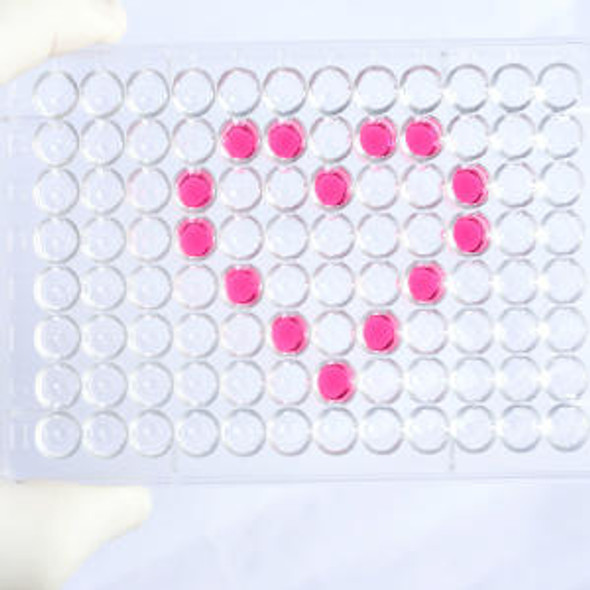Rat Signaling ELISA Kits 4
Rat SNCa (Synuclein Alpha) ELISA Kit (RTES00961)
- SKU:
- RTES00961
- Product Type:
- ELISA Kit
- Size:
- 96 Assays
- Uniprot:
- P37377
- Sensitivity:
- 9.38pg/mL
- Range:
- 15.63-1000pg/mL
- ELISA Type:
- Sandwich
- Synonyms:
- SNC-A, aSYN, PD1,NACP, PARK1, PARK4,
- Reactivity:
- Rat
- Sample Type:
- Serum, plasma and other biological fluids
Description
| Assay type: | Sandwich |
| Format: | 96T |
| Assay time: | 4.5h |
| Reactivity: | Rat |
| Detection Method: | Colormetric |
| Detection Range: | 15.63-1000 pg/mL |
| Sensitivity: | 9.38 pg/mL |
| Sample Volume Required Per Well: | 100µL |
| Sample Type: | Serum, plasma and other biological fluids |
| Specificity: | This kit recognizes Rat SNCa in samples. No significant cross-reactivity or interference between Rat SNCa and analogues was observed. |
This ELISA kit uses Sandwich-ELISA as the method. The micro ELISA plate provided in this kit has been pre-coated with an antibody specific to Rat SNCa. Standards or samples are added to the appropriate micro ELISA plate wells and combined with the specific antibody. Then a biotinylated detection antibody specific for Rat SNCa and Avidin-Horseradish Peroxidase (HRP) conjugate are added to each micro plate well successively and incubated. Free components are washed away. The substrate solution is added to each well. Only those wells that contain Rat SNCa, biotinylated detection antibody and Avidin-HRP conjugate will appear blue in color. The enzyme-substrate reaction is terminated by adding Stop Solution and the color turns yellow. The optical density (OD) is measured spectrophotometrically at a wavelength of 450 nm ± 2 nm. The OD value is proportional to the concentration of Rat SNCa. The concentration of Rat SNCa in samples can be calculated by comparing the OD of the samples to the standard curve.
| UniProt Protein Function: | SNCA: a member of the synuclein family. Abundantly expressed in the brain. Inhibits phospholipase D2 selectively. May integrate presynaptic signaling and membrane trafficking. Implicated in the pathogenesis of Parkinson's disease. A major component of amyloid plaques in the brains of patients with Alzheimer's disease. Two alternatively spliced isoforms transcripts have been identified. |
| UniProt Protein Details: | Protein type:Adaptor/scaffold Cellular Component: actin cytoskeleton; axon; cell cortex; cell junction; cytoplasm; cytoplasmic vesicle membrane; cytoskeleton; cytosol; extracellular space; fibril; Golgi apparatus; growth cone; inclusion body; intracellular membrane-bound organelle; membrane; mitochondrion; nerve terminal; nuclear outer membrane; nucleus; perinuclear region of cytoplasm; plasma membrane; platelet alpha granule membrane; ribosome; rough endoplasmic reticulum; synapse; synaptic vesicle; terminal button Molecular Function:alpha-tubulin binding; arachidonic acid binding; beta-tubulin binding; calcium ion binding; caspase inhibitor activity; copper ion binding; dynein binding; enzyme binding; fatty acid binding; ferrous iron binding; histone binding; identical protein binding; kinesin binding; magnesium ion binding; microtubule binding; oxidoreductase activity; phospholipase binding; phospholipid binding; phosphoprotein binding; protein binding; protein domain specific binding; protein N-terminus binding; tau protein binding; zinc ion binding Biological Process: adult locomotory behavior; aging; behavioral response to cocaine; calcium ion homeostasis; caspase activation; dopamine biosynthetic process; dopamine metabolic process; fatty acid metabolic process; microglial cell activation; mitochondrial membrane organization and biogenesis; negative regulation of apoptosis; negative regulation of caspase activity; negative regulation of dopamine metabolic process; negative regulation of dopamine uptake; negative regulation of exocytosis; negative regulation of histone acetylation; negative regulation of microtubule polymerization; negative regulation of monooxygenase activity; negative regulation of neuron apoptosis; negative regulation of norepinephrine uptake; negative regulation of protein amino acid phosphorylation; negative regulation of serotonin uptake; negative regulation of transporter activity; neutral lipid metabolic process; organelle ATP synthesis coupled electron transport; phospholipid metabolic process; positive regulation of endocytosis; positive regulation of neurotransmitter secretion; positive regulation of peptidyl-serine phosphorylation; positive regulation of receptor recycling; positive regulation of release of sequestered calcium ion into cytosol; positive regulation of synaptic transmission; protein destabilization; receptor internalization; regulation of acyl-CoA biosynthetic process; regulation of dopamine secretion; regulation of excitatory postsynaptic membrane potential; regulation of glutamate secretion; regulation of locomotion; regulation of long-term neuronal synaptic plasticity; regulation of macrophage activation; regulation of neuron apoptosis; regulation of neuronal synaptic plasticity; regulation of neurotransmitter secretion; response to cocaine; response to drug; response to iron(II) ion; response to lipopolysaccharide; response to magnesium ion; synapse organization and biogenesis; synaptic transmission; synaptic transmission, dopaminergic; synaptic vesicle endocytosis; synaptic vesicle transport |
| NCBI Summary: | may play a role in regulation of synaptic vesicle biogenesis and organization; may be involved in neurotransmission [RGD, Feb 2006] |
| UniProt Code: | P37377 |
| NCBI GenInfo Identifier: | 9507125 |
| NCBI Gene ID: | 29219 |
| NCBI Accession: | NP_062042. 1 |
| UniProt Secondary Accession: | P37377,P37378, Q53YM9, |
| UniProt Related Accession: | P37377 |
| Molecular Weight: | 41. 9kD |
| NCBI Full Name: | alpha-synuclein |
| NCBI Synonym Full Names: | synuclein alpha |
| NCBI Official Symbol: | Snca |
| NCBI Protein Information: | alpha-synuclein |
| UniProt Protein Name: | Alpha-synuclein |
| Protein Family: | Alpha-synuclein |
| UniProt Gene Name: | Snca |
| UniProt Entry Name: | SYUA_RAT |
As the OD values of the standard curve may vary according to the conditions of the actual assay performance (e. g. operator, pipetting technique, washing technique or temperature effects), the operator should establish a standard curve for each test. Typical standard curve and data is provided below for reference only.
| Concentration (pg/mL) | O.D | Average | Corrected |
| 1000 | 2.336 2.344 | 2.34 | 2.283 |
| 500 | 1.529 1.567 | 1.548 | 1.491 |
| 250 | 0.934 0.91 | 0.922 | 0.865 |
| 125 | 0.476 0.482 | 0.479 | 0.422 |
| 62.5 | 0.253 0.225 | 0.239 | 0.182 |
| 31.25 | 0.167 0.147 | 0.157 | 0.1 |
| 15.63 | 0.099 0.117 | 0.108 | 0.051 |
| 0 | 0.047 0.067 | 0.057 | -- |
Precision
Intra-assay Precision (Precision within an assay): 3 samples with low, mid range and high level Rat SNCa were tested 20 times on one plate, respectively.
Inter-assay Precision (Precision between assays): 3 samples with low, mid range and high level Rat SNCa were tested on 3 different plates, 20 replicates in each plate.
| Intra-assay Precision | Inter-assay Precision | |||||
| Sample | 1 | 2 | 3 | 1 | 2 | 3 |
| n | 20 | 20 | 20 | 20 | 20 | 20 |
| Mean (pg/mL) | 45.79 | 112.15 | 482.01 | 50.05 | 122.68 | 440.06 |
| Standard deviation | 2.49 | 6.15 | 20.53 | 2.56 | 5.02 | 22.14 |
| C V (%) | 5.44 | 5.48 | 4.26 | 5.11 | 4.09 | 5.03 |
Recovery
The recovery of Rat SNCa spiked at three different levels in samples throughout the range of the assay was evaluated in various matrices.
| Sample Type | Range (%) | Average Recovery (%) |
| Serum (n=5) | 90-102 | 95 |
| EDTA plasma (n=5) | 92-104 | 99 |
| Cell culture media (n=5) | 94-107 | 100 |
Linearity
Samples were spiked with high concentrations of Rat SNCa and diluted with Reference Standard & Sample Diluent to produce samples with values within the range of the assay.
| Serum (n=5) | EDTA plasma (n=5) | Cell culture media (n=5) | ||
| 1:2 | Range (%) | 98-109 | 92-106 | 90-106 |
| Average (%) | 104 | 99 | 97 | |
| 1:4 | Range (%) | 90-100 | 80-91 | 85-97 |
| Average (%) | 95 | 86 | 92 | |
| 1:8 | Range (%) | 88-100 | 84-95 | 81-94 |
| Average (%) | 95 | 89 | 88 | |
| 1:16 | Range (%) | 92-107 | 81-92 | 83-95 |
| Average (%) | 98 | 86 | 89 |
An unopened kit can be stored at 4°C for 1 month. If the kit is not used within 1 month, store the items separately according to the following conditions once the kit is received.
| Item | Specifications | Storage |
| Micro ELISA Plate(Dismountable) | 8 wells ×12 strips | -20°C, 6 months |
| Reference Standard | 2 vials | |
| Concentrated Biotinylated Detection Ab (100×) | 1 vial, 120 µL | |
| Concentrated HRP Conjugate (100×) | 1 vial, 120 µL | -20°C(shading light), 6 months |
| Reference Standard & Sample Diluent | 1 vial, 20 mL | 4°C, 6 months |
| Biotinylated Detection Ab Diluent | 1 vial, 14 mL | |
| HRP Conjugate Diluent | 1 vial, 14 mL | |
| Concentrated Wash Buffer (25×) | 1 vial, 30 mL | |
| Substrate Reagent | 1 vial, 10 mL | 4°C(shading light) |
| Stop Solution | 1 vial, 10 mL | 4°C |
| Plate Sealer | 5 pieces | |
| Product Description | 1 copy | |
| Certificate of Analysis | 1 copy |
- Set standard, test sample and control (zero) wells on the pre-coated plate and record theirpositions. It is recommended to measure each standard and sample in duplicate. Note: addall solutions to the bottom of the plate wells while avoiding contact with the well walls. Ensuresolutions do not foam when adding to the wells.
- Aliquot 100µl of standard solutions into the standard wells.
- Add 100µl of Sample / Standard dilution buffer into the control (zero) well.
- Add 100µl of properly diluted sample (serum, plasma, tissue homogenates and otherbiological fluids) into test sample wells.
- Cover the plate with the sealer provided in the kit and incubate for 90 min at 37°C.
- Aspirate the liquid from each well, do not wash. Immediately add 100µL of BiotinylatedDetection Ab working solution to each well. Cover the plate with a plate seal and gently mix. Incubate for 1 hour at 37°C.
- Aspirate or decant the solution from the plate and add 350µL of wash buffer to each welland incubate for 1-2 minutes at room temperature. Aspirate the solution from each well andclap the plate on absorbent filter paper to dry. Repeat this process 3 times. Note: a microplatewasher can be used in this step and other wash steps.
- Add 100µL of HRP Conjugate working solution to each well. Cover with a plate seal andincubate for 30 min at 37°C.
- Aspirate or decant the solution from each well. Repeat the wash process for five times asconducted in step 7.
- Add 90µL of Substrate Reagent to each well. Cover with a new plate seal and incubate forapproximately 15 min at 37°C. Protect the plate from light. Note: the reaction time can beshortened or extended according to the actual color change, but not by more than 30min.
- Add 50 µL of Stop Solution to each well. Note: Adding the stop solution should be done inthe same order as the substrate solution.
- Determine the optical density (OD value) of each well immediately with a microplate readerset at 450 nm.






